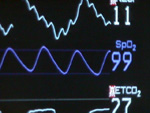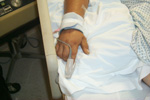Pulse Oximetry
What is pulse oximetry?
Pulse oximetry is the study of arterial oxygen saturation, the amount of oxygen dissolved in the blood. A pulse oximeter is the device that measures and displays the oxygen arterial saturation.
How does pulse oximetry work?
The pulse oximeter is a small device that has to be in contact with the skin to detect the oxygen saturation. The device is usually place on the patient's finger, earlobe, toe or nose. The pulse oximeter gives off light that determines the oxygen saturation of the blood. The pulse oximeter is connected to a digital screen where the arterial saturation is constantly shown.
Does pulse oximetry hurt?
Pulse oximetry does not hurt.
Are there any potential complications associated with use of the pulse oximeter?
There are no complications associated with the use of pulse oximetry. Under certain circumstances the pulse oximeter may give false readings.
Pulse oximeter reading of 99 demonstrated on a bedside monitor

Pulse oximeter probe on index finger
